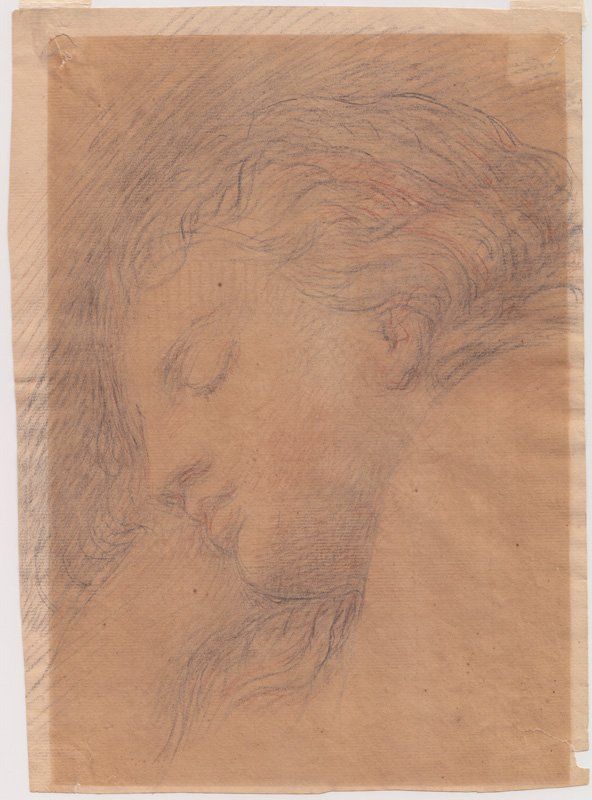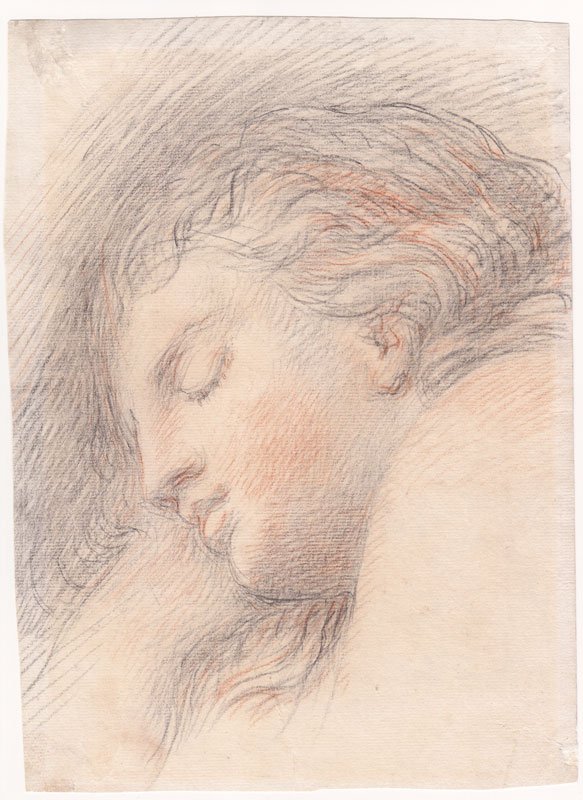The Conservation of Charcoal and Sanguine Drawings
Case Study: The Conservation of Charcoal and Sanguine Drawings
- Title : Head of a Sleeping Woman
- Author : Unknown
- Technique : Charcoal and Sanguine
The discoloration of this paper was strong enough to attempt to remove at least part of it. The cleaning of the paper was performed with the wet blotting technique. This procedure is based in the capillarity forces created between the original support and the blotting papers. Initially, the wet blotting papers transmit the humidity to the original support. In this case, after the conservation of charcoal and sanguine drawing, the paper was substantially lighter allowing for the chromatic values of the drawing to be seen.
Charcoal and sanguine, along with related friable media such as pastel and conté, are among the most delicate artistic materials used on paper. Their soft, powdery nature makes them highly susceptible to smudging, abrasion, and accidental loss. While artists sometimes stabilize these media using fixatives, these interventions can alter the surface texture, color, and optical depth, diminishing the subtleties of tonal gradation. Consequently, conservators generally avoid fixatives and instead focus on careful stabilization, paper cleaning, and preventive care.
One of the main challenges in conserving charcoal or sanguine drawings is the fragile attachment of the media to the paper support. Even partially fixed works may be unsuitable for full immersion washing, yet the paper itself may have suffered discoloration, yellowing, or minor staining. Conservators aim to reduce these visual distractions without disturbing the original media.
Cleaning in the Conservation of Charcoal and Sanguine Drawings
A commonly cleaning method is wet blotting, which relies on capillary forces to extract soluble discolorants from the paper. Slightly dampened blotters introduce controlled moisture to the support, softening discoloration while leaving the surface media largely undisturbed. A dry blotting sheet placed beneath the paper draws both moisture and discoloration products away from the support. By repeating this process in carefully monitored cycles, conservators can substantially lighten the paper, improving visual clarity without mechanical contact with the friable media.
Throughout treatment, protection of the media is essential. Interleaving with thin Japanese tissue, working from the reverse side, and controlling humidity ensures that charcoal, sanguine, pastel, or conté remain in place. Direct brushing or pressing on the surface is avoided, preserving delicate line work, shading, and subtle tonal variations.
After treatment, the artwork often appears significantly brighter, allowing the full chromatic and tonal range of the media to be appreciated. Soft gradations, hatching, and highlights become more visible, while the original expressive qualities of the drawing are maintained. Importantly, these results are achieved without overpainting, retouching, or altering the visual character of the media.
Preventive Care
Preventive conservation complements active treatment. Stable environmental conditions—moderate temperature, controlled relative humidity, and minimal light exposure—reduce the risk of smudging and further deterioration. Proper storage, including acid-free interleaving, custom supports, and careful handling, protects both the paper and the media. By combining preventive strategies with precise treatment techniques, conservators ensure that fragile drawings remain stable and visually legible for generations.
In conclusion, the conservation of charcoal, sanguine, and other friable media on paper demands a delicate balance between preservation of material integrity and enhancement of visual clarity. Methods such as wet blotting, interleaving, and controlled hydration allow discoloration to be reduced while safeguarding the original media. With careful, minimally invasive intervention, these fragile works can be stabilized, restored, and appreciated without compromising the artist’s intent.


